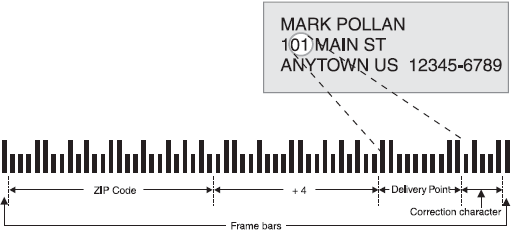POSTNET Barcode
This Symbology is also known as USPS
POSTNET Barcode, USPS POSTal Numeric Encoding Technique Barcode, Delivery Point
Barcode (DPBC), Postnet 3 of 5
Overview

The POSTNET (POSTal Numeric
Encoding Technique) barcode was developed by the US Postal Service to encode
ZIP Code information on letter mail for rapid and reliable sorting by BCSs. The
POSTNET barcode can represent a five-digit ZIP Code (32 bars), a nine-digit
ZIP+4 code (52 bars), or an eleven-digit delivery point code (62 bars).
The Delivery Point Barcode (DPBC) is formed by adding 10 bars
to an existing ZIP+4 barcode. The 10 bars represent two additional digits
(normally the last two digits of the street address, post office box, rural
route number, or highway contract route number).

The Delivery Point Barcode (DPBC) - USPS POSTNET
The POSTNET barcode is always printed in a format that begins
and ends with a frame bar (full or tall bar). To ensure POSTNET accuracy during
mail processing, a correction character a.k.a. Checksum (five bars) must be
included immediately before the rightmost frame bar of all POSTNET barcodes.
How to create USPS POSTNET barcodes using Barcode
Professional
Note: Please refer to the Class
Reference documentation for more information about the properties and methods
stated in this document.
In order to get an USPS POSTNET barcode image, please follow
these steps:
-
Set the Symbology property to Postnet
-
Setting up dimensions and quiet zones:
-
Set the PostnetHeightShortBar property to a value ranging from 0.04
to 0.06 (Values are expressed in Inches)
-
Set the PostnetHeightTalltBar property to a value ranging from 0.115
to 0.135 (Values are expressed in Inches)
-
Set the BarWidth property to a value ranging from 0.015 to 0.025
(Values are expressed in Inches)
-
Set the BarRatio property to 1 or 2 (Try 1 first)
-
Set the QuietZoneWidth property (Value is expressed in Inches)
-
Set the TopMargin and BottomMargin properties (Value is expressed
in Inches)
-
Setting up the value to encode:
-
Set the Code property with a value with the following structure:
-
For five-digit ZIP Code (32 bars): specify the 5 digits only
-
For nine-digit ZIP+4 code (52 bars): specify the 9 digits only
-
For eleven-digit delivery point code (62 bars): specify the 11 digits
only
-
Set the Text property to an Empty string
-
Barcode Professional will automatically generate and append the checksum value
-
Tip 1: You can disable this behavior by setting up to False the AddChecksum
property
-
Tip 2: You can leave AddChecksum property set to True but
rid of the checksum value from the Human Readable text by setting up to False
the DisplayChecksum property
USPS PLANET barcode images sample
Nine-digit ZIP+4 code (52 bars) POSTNET Example
Example of a POSTNET barcode for a nine-digit ZIP+4 code 20260-9900. The
checksum is not specified and is automatically calculated and appended by
Barcode Professional.
Code property = 202609900 and AddChecksum
property = True will produce the following barcode image:
 The POSTNET (POSTal Numeric
Encoding Technique) barcode was developed by the US Postal Service to encode
ZIP Code information on letter mail for rapid and reliable sorting by BCSs. The
POSTNET barcode can represent a five-digit ZIP Code (32 bars), a nine-digit
ZIP+4 code (52 bars), or an eleven-digit delivery point code (62 bars).
The POSTNET (POSTal Numeric
Encoding Technique) barcode was developed by the US Postal Service to encode
ZIP Code information on letter mail for rapid and reliable sorting by BCSs. The
POSTNET barcode can represent a five-digit ZIP Code (32 bars), a nine-digit
ZIP+4 code (52 bars), or an eleven-digit delivery point code (62 bars).
